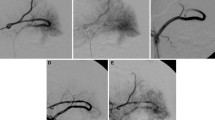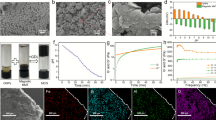Abstract
To prepare a soluble gelatin sponge (GS) and to explore the GS particles (GSPs) that inhibit development of collateral pathways when transcatheter hepatic arterial embolization is performed. The approval of the Institutional Committee on Research Animal Care of our institution was obtained. By means of 50 and 100 kDa of regenerative medicine–gelatin (RM-G), RM-G sponges were prepared by freeze-drying and heating to temperatures of 110–150°C for cross-linkage. The soluble times of RM-GSPs were measured in vitro. Eight swine for transcatheter hepatic arterial embolization were assigned into two groups: six received 135°C/50RM-GSPs, 125°C/100RM-GSPs, and 138°C/50RM-GSPs, with soluble time of 48 h or more in vitro; two swine received Gelpart GSPs (G-GSPs) with insoluble time of 14 days as a control. Transarterial chemoembolization was performed on two branches of the hepatic artery per swine. RM-GSPs heated at temperatures of 110–138°C were soluble. Mean soluble times of the RM-GSPs increased with higher temperature. Hepatic branches embolized with G-GSP remained occluded after 6 days, and development of collateral pathways was observed after 3 days. Hepatic branches embolized with 135°C/50RM-GSP and 125°C/100RM-GSP remained occluded for 4 h, and recanalization was observed after 1 day. Hepatic branches embolized with 138°C/50RM-GS remained occluded for 1 day, and recanalization was observed after 2 days with no development of collateral pathways. In RM-GSs with various soluble times that were prepared by modulating the heating temperature, 138°C/50RM-GSP was the soluble GSP with the longest occlusion time without inducing development of collateral pathways.




Similar content being viewed by others
References
Doyon D, Mouzon A, Jourde AM et al (1974) L’embolisation arterielle hepatique dans les tumoeurs malignes du foie. Ann Radiol 17:593–603
Goldstein HM, Wallace S, Anderson JH et al (1976) Transcatheter occlusion of abdominal tumors. Radiology 120:539–545
Yamada R, Sato M, Kawabata M et al (1983) Hepatic artery embolization in 120 patients with unresectable hepatoma. Radiology 148:397–401
Katsumori T, Kasahara T (2006) The size of gelatin sponge particles: differences with preparation method. Cardiovasc Intervent Radiol 29:1077–1083
Kim HC, Chung JW, Hong S et al (2007) Hepatocellular carcinoma with internal mammary artery supply: feasibility and efficacy of transcatheter chemoembolization and factors affecting patient prognosis. J Vasc Interv Radiol 16:611–620
Nakai M, Sato M, Kawai N et al (2001) Hepatocellular carcinoma: involvement of the internal mammary artery. Radiology 219:147–152
Tanabe N, Iwasaki T, Chida N et al (1998) Hepatocellular carcinoma supplied by inferior phrenic arteries. Acta Radiol 39:443–447
Kim HC, Chung W, Lee W et al (2005) Recognizing extrahepatic collateral vessels that supply hepatocellular carcinoma to avoid complications of transcatheter arterial chemoembolization. RadioGraphics 25:25–39
Charnsangavei C, Chuang VP, Wallace S et al (1982) Angiographic classification of hepatic arterial collaterals. Radiology 144:485–494
Soo CS, Chuang VP, Wallace S et al (1983) Treatment of hepatic neoplasm through extrahepatic collaterals. Radiology 147:45–49
Chung JW, Kim HC, Yoon JH et al (2006) Transcatheter arterial chemoembolization of hepatocellular carcinoma: prevalence and causative factors of extrahepatic collateral arteries in 479 patients. Korean J Rasiol 7:257–266
Sato M, Yamada R (1983) Experimental and clinical studies on the hepatic artery embolization for treatment of hepatoma. Nippon Acta Radiologica 43:977–1005
Kanayama Y, Aoki C, Sakai Y (2007) Development of low endotoxin gelatin for regenerative medicine. Biol Pharm Bull 30:237–241
Tanaka K, Sato M, Terada M et al (1988) Echogenic spots early after hepatic arterial embolization. Jpn J Med Ultrasonics 15:397–403
Segall H (1923) An experimental anatomical investigation of blood and bile channels of the liver. Surg Gynecol Obstet 37:152–178
Healey JE Jr, Schroy PC, Sorensen RJ (1953) The intrahepatic distribution of the hepatic artery in man. J Int Coll Surg 20:133–148
Hayashi K, Ina H, Tezuka M et al (2007) Local therapeutic results of computed tomography–guided transcatheter arterial chemoembolization for hepatocellular carcinoma: results of 265 tumors in 79 patients. Cardiovasc Intervent Radiol 30:1144–1155
Acknowledgments
No financial disclosures exist.
Author information
Authors and Affiliations
Corresponding author
Rights and permissions
About this article
Cite this article
Takasaka, I., Kawai, N., Sato, M. et al. A New Soluble Gelatin Sponge for Transcatheter Hepatic Arterial Embolization. Cardiovasc Intervent Radiol 33, 1198–1204 (2010). https://doi.org/10.1007/s00270-010-9866-2
Received:
Accepted:
Published:
Issue Date:
DOI: https://doi.org/10.1007/s00270-010-9866-2




